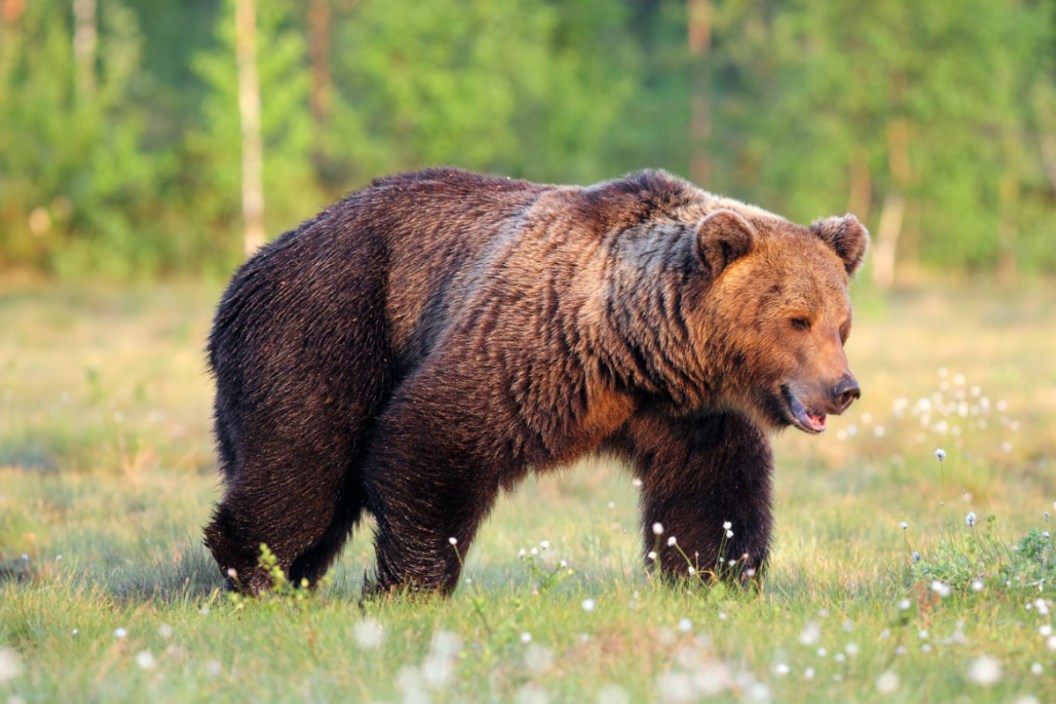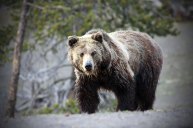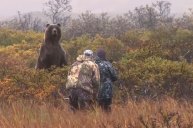As outdoors enthusiasts, probably the scariest thing any of us could ever imagine running into while out enjoying nature is a massive bear. It doesn't happen very often, but to those it does, we're often scarred emotionally and physically for life. Fortunately, bears are usually more frightened of us than we are of them and many surprise wildlife encounters in remote areas end simply with a startled human's heart rate elevated as a big bruin flees the scene. But some encounters end badly, and it's worth reading about them to learn some vital bear safety tips for the next time you find yourself in bear country. While you may think most attacks happen in the United States and Canada, we found a few truly horrific ones that have happened in other countries too. You will want to keep these in mind every time you go into brown or even black bear territory with a focus on safety and awareness.
Tom Sommer, Grizzly Bear, Montana, Non-fatal
This grizzly bear attack happened in 2017 and went wildly viral for the photos of Sommer's wounds. He and a friend were hunting in the backcountry in Montana when they unexpectedly walked up on a grizzly feeding on a carcass.
While Sommer's friend warded off the bear with a blast of bear spray, Sommer wasn't so lucky. The big bruin chased him twice around a tree and knocked his handgun from his hand.
The bear first took a bite of Sommer's leg before taking the man's skull in its mouth. Sommer heard his skull crack in the bear's mouth before the animal was chased off with another blast of bear spray by Sommer's hunting partner.
The man had to be transported back to civilization via a 5-mile mule ride, and then had to endure 90 stitches to close the unbelievable gash in his head. Montana wildlife officials decided not to pursue and euthanize the bear because it was reacting naturally to being surprised.
We're just glad it all worked out in the end for all parties, including the bear. We also imagine Sommer has a gnarly scar and story to tell after this encounter. That's why you should always make sure you're making plenty of noise in bear country to let the animals know you're around.
Hugh Glass, Grizzly Bear, South Dakota, Non-Fatal
The story of Hugh Glass was, of course, made world-famous in the Leonardo DiCaprio movie "The Revenant" in 2015. In 1823, Glass was part of a fur-trading expedition in northwestern South Dakota when he had the misfortune of startling a sow grizzly with cubs.
Some of the details of this attack have been lost to history. The movie portrayed Glass killing the grizzly himself, although it seems likely some of the other members of the fur trapping party helped. Whatever the case may be, we know he did survive and was, by all accounts, a total mess after the attack. So much so that the other members of the party believed he would not live and abandoned him.
Yet somehow, Glass survived the grizzly attack and then, in an equally unbelievable move, managed to crawl, walk, and eventually float in a canoe almost 250 miles south to Fort Kiowa near present-day Chamberlin, SD.
Of course, part of Glass' legend is that he sought revenge on two members of the expedition for abandoning him once he'd healed. Once again, history is unclear on if he actually got that revenge.
We do know Glass lived for ten more years after the mauling before being killed by Arikara Native Americans. This American frontiersman's legend lives on in the Hugh Glass Recreation Area near the site of the attack in Shadehill, SD.
The Sankebetsu Brown Bear Incident, Japan, Seven fatal attacks
When one thinks of bear encounters, they generally don't think of Japan. But in December 1915, a remote area of Northern Japan was stricken by some of the worst fatal bear attacks in the history of the world.
For a full week, a nearly 800-pound Ussuri brown bear went on a bloody rampage through the tiny village of Rokusen-sawa, leaving behind seven dead bodies in its wake.
The bear was first spotted displaying an abnormal non-fear of humans in mid-November of that year. But it wasn't until Dec. 9, 1915, that the bruin finally left its bear habitat behind and boldly attacked a home.
The animal first killed a baby and then a woman who tried to fight back. Over the next five days, the bear maulings continued as the bruin attempted to break into homes in search of victims. In at least two cases, it was successful in getting in and carrying off humans. Bear tracks and body parts littered the scenes of the crime.
Eventually, a bear expert named Yamamoto Heikichi arrived on the scene. With the help of local hunters, he set up an ambush for the bear using the body of one of the victims as bait. The hunting party managed to only wound the bear.
The next day they tracked down the animal and put it down for good. When they cut it open, pieces of the victims were found still in the bear's stomach.
The incident had a profound effect on the town of Rokusen-sawa. Many moved away in the wake of the rampage. The village's mayor had a son who took things so personally that he killed over 100 bears in an act of revenge in the years that followed. Today, a shrine and statue of the bear in the area commemorate the horrible events of 1915.
Wes Perkins, Grizzly Bear, Alaska, Non-Fatal
It is nothing short of a miracle that Wes Perkins is still alive to tell his story today. Perhaps no other human on the planet has survived a worse bear mauling and lived to tell the tale.
In September 2016, Perkins and two other men were bear hunting on the Seward Peninsula when a huge boar attacked him. The other two men managed to shoot the grizzly off Perkins, but not before the big bruin ripped the man's face off. Literally.
Luckily, Perkins was a trained paramedic and realized how precarious his situation was. The man literally had to dig debris out of his airway in order to breathe. Then he stayed conscious the entire trip to a hospital in Nome. We can't even fathom the pain and fear he had to be experiencing. Perkins was later taken to Seattle for even more intensive care. How bad was it? Well, he had 26 surgeries in total, and medical expenses were estimated to exceed the $1 million mark. The doctors managed to reconstruct quite a bit of his face, but last we heard, he was still eating food in liquid form. He also lost sight in one eye, and because the bear took part of his tongue, he has difficulty speaking. This animal ruined this man's life.
It should be mentioned that Perkins is an experienced bear hunter, and many Alaskans who knew him were surprised to hear he had been attacked. But it just goes to show something like this can happen to anyone if you're unfortunate enough to catch the animal by surprise.
Svalbard Archipelago Attack, Polar Bear, Norway, One Fatal, 4 injured
This attack is an unfortunate example of being unprepared in bear country. In August 2011, 17-year-old Horatio Chapple and 12 others were on a camping trip on a remote Norwegian island as part of British Schools Exploring Society camping trip, when a starving polar bear invaded the camp in the middle of the night.
Two days prior, Chapple and his friends had discovered bear tracks in the area, but a later investigation revealed the party was woefully unprepared to deal with a wild animal attack. The camp had a series of trip wires attached to explosives designed to deter bears. But, the trip wires failed to go off and the bear ripped into Chapple's tent and inflicted fatal wounds to his head and upper body.
The camp did have a firearm. But it was an ancient Mauser, a relic of World War II, and the camp's supervising adults were inadequately trained to handle it. One of the adults tried to shoot the bear several times, but it failed to fire because the safety was in a position that disabled the firing mechanism. The bear injured four more campers before another adult finally got the gun working and shot the bear dead. By that point, it was too late for Chapple. The bear was later shown to be of an advanced age and had failing teeth, much like many big cats that later moved to hunting humans.
Norwegian officials later criticized the group for being unprepared for camping in polar bear country and not having anyone standing watch, even though the group had found bear sign in the area in the days prior. Chapple's parents later said had they known just how unprepared the expedition was, they would have never allowed their son to go on the trip.
Timothy Treadwell and Amie Huguenard, Brown Bear, Alaska, Fatal
Timothy Treadwell gained notoriety as a filmmaker who loved camping with the bear populations in Alaska's Katmai National Park, which he did for 13 years straight as he documented the bears there.
Many of Treadwell's exploits were displayed in the 2005 documentary Grizzly Man, which featured footage of him getting dangerously close to the wild bears, seemingly for the sake of the camera. The footage brought Treadwell fame, and he even appeared on the David Letterman's show. Chillingly, Letterman asked Treadwell if one day they'd read about him being eaten, to which Treadwell replied: "No." Treadwell also caused problems for the National Park Service, who often cited him for not moving his campsite according to regulations, illegally guiding tourists, and improperly storing food. While he had his supporters, most people believed he was probably playing with fire.
Luck finally ran out for Treadwell and his girlfriend Amie Huguenard on Oct. 6, 2003. The night before the two were scheduled to leave the park for the season, a bear Treadwell knew attacked the couple in their tent. One of the couple's cameras was turned out in the struggle, and audio was recorded of Treadwell's last moments, although it has never been released to the public. For obvious reasons. The few who have heard the audio say it is absolutely horrific.
The next morning the pilot who came to pick up the couple discovered their mostly-eaten remains scattered around the campsite. All that was left of Treadwell was his head, part of his spine, hand, and right forearm. The bear buried what was left of Huguenard in an apparent attempt to store it for later consumption.
Officials investigating the scene shot and killed the bear and another younger one that was hanging around the area. Further investigation of the cameras left at the site found Treadwell had actually filmed the bear that killed him just days prior to the attack.
Brian Matayoshi and John Wallace, Grizzly Bear, Wyoming, Fatal
These two men died in separate incidents roughly a month apart in Wyoming's Yellowstone National Park, but there is speculation that the same bear may have been responsible for both incidents.
Matayoshi was the first to be attacked. He and his wife were hiking Wapiti Lake Trail on July 6, 2011, when they startled a sow with cubs. The couple tried to run away, but the bear caught the husband first and killed him. His wife survived by playing dead. One cannot even begin to fathom how horrific and traumatic this experience was.
A few months later, on Aug. 24, 2011, Wallace was fatally mauled by a grizzly on Mary Mountain Trail. In the aftermath of the attack, it was revealed Wallace did not carry bear spray or a firearm for protection. What's more, when park officials tried to explain to him rules about bear safety, he brushed them off. Allegedly, Wallace called himself a "grizzly bear expert." The subsequent investigation revealed Wallace was likely ambushed by the bear while taking a break on a log.
Wildlife biologists also discovered that the bear that killed Matayoshi was in the area at the time of the attack. While they couldn't be certain the same bear was responsible for both deaths, they decided to euthanize the bear just in case.
It goes without saying, but 2011 wasn't a good year for Yellowstone, as the attacks marked the first fatal incidents involving bruins in 25 years for the park.
For more outdoor content from Travis Smola, be sure to follow him on Twitter and check out his Geocaching and General Outdoor Youtube Channels.
READ MORE: THE MOST FAMOUS SHARK ATTACKS IN HISTORY




